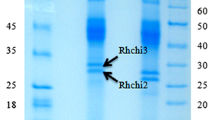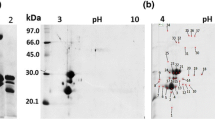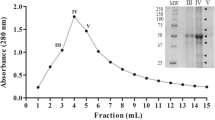Abstract
Colletotrichum kahawae is the causal agent of the coffee berry disease, infecting leaves and coffee berries at any stage of their development. Colletotrichum gloeosporioides is the causal agent of brown blight, infecting ripe berries only. Both fungi secrete the same pattern of carboxylesterases to the fermentation broth when cutin is used as carbon source. By using two different strategies composed of two precipitation steps (ammonium sulphate and acetic acid precipitation) and two chromatographic steps, two proteins displaying carboxylesterase activity were purified to electrophoretic homogeneity. One, with a molecular weight (MW) of 21 kDa, has a blocked N terminus and was identified as cutinase by peptide mass fingerprint and mass spectrometry/mass spectrometry data acquired after peptide derivatization with 4-sulphophenyl isothiocyanate. The second, with a MW of 40 kDa, displays significant carboxylesterase activity on tributyrin but low activity on p-nitrophenyl butyrate. N-terminal sequencing for this protein does not reveal any homology to other carboxylesterases. These two enzymes, which were secreted by both fungi, appear homologous.






Similar content being viewed by others
References
Bostock RM, Wilcox SM, Wang G, Adaskaveg JE (1999) Suppression of Monilinia fructicola cutinase production by peach fruit surface phenolic acids. Physiol Mol Plant Pathol 54:37–50
Brocklehurst K (1993) Electrochemical assays: the pH–stat. In: Eisenthal R, Danson MJ (eds) Enzyme assays, a practical approach. Oxford University Press, Oxford, pp 191–206
Carvalho CM, Aires-Barros MR, Cabral JMS (1999) Cutinase: from molecular level to bioprocess development. Biotechnol Bioeng 66:17–34
Chen ZJ, Liang JS, Rodrigues Jr CJ (2005) Colletotrichum gloeosporioides can overgrow Colletotrichum kahawae on green coffee berries first inoculated with C. kahawae. Biotechnol Lett 27:679–682
Darbinian-Sarkissian N, Darbinyan A, Otte J, Radhakrishnan S, Sawaya BE, Arzumanyan A, Chipitsyna G, Popov Y, Rappaport J, Amini S, Khalili K (2006) p27(SJ), a novel protein in St John’s Wort, that suppresses expression of HIV-1 genome. Gene Ther 13:288–295
Degani O, Salmanb H, Gepsteina S, Dosoretz CG (2006) Synthesis and characterization of a new cutinase substrate, 4-nitrophenyl (16-methyl sulfone ester) hexadecanoate. J Biotechnol 121:346–350
Dickman MB, Patil SS, Kolattukudy PE (1982) Purification, characterization and role in infection of an extracellular cutinolytic enzyme from Colletotrichum gloeosporioides penz on Carica papaya L. Physiol Plant Pathol 20:333–347
Dickman MB, Padila GK, Kolattukudy PE (1989) Insertion of cutinase gene into a wound pathogen enables it to infect intact host. Nature 342:446–448
Ettinger WF, Thukral SK, Kolattukudy PE (1987) Structure of cutinase gene, cDNA, and the derived amino acid sequence from phytopathogenic fungi. Biochemistry 26:7883–7892
Gobom J, Nordhoff E, Mirgorodskaya E, Ekman R, Roespstorff P (1999) Sample purification and preparation technique based on nano-scale reversed-phase columns for the sensitive analysis of complex peptide mixtures by matrix-assisted laser desorption/ionization mass spectrometry. J Mass Spectrom 34:105–116
Hain NA, Stuhlmuller B, Hahn GR, Kalden JR, Deutzmann R, Burmester GR (1996) Biochemical characterization and microsequencing of a 205-kDa synovial protein stimulatory for T cells and reactive with rheumatoid factor containing sera. J Immunol 157:1773–1780
Hodeland C, Lee Y, Min D, Mrksich M (2002) Selective immobilization of proteins to self-assembled monolayers presenting active site-directed capture ligands. Proc Natl Acad Sci USA 99:5048–5052
Kolattukudy PE (1984) Cutinase from fungi and pollen. In: Borgstrom B, Brockman H (eds) Lipases. Elsevier, Amsterdam, pp 471–504
Kolattukudy PE, Purdy RE, Maiti IB (1981) Cutinase from fungi and pollen. Methods Enzymol 71:652–664
Kolattukudy PE, Rogers LM, Li D, Hwang CS, Flaishman MA (1995) Surface signalling in pathogenesis. Proc Natl Acad Sci USA 92:4080–4087
Köller W, Parker DM (1989) Purification and characterization of cutinase from Venturia inaequalis. Phytopathology 79:278–283
Koops BC, Verheij HM, Slotboom AJ, Egmond MR (1999) Effect of chemical modification on the activity of lipases in organic solvents. Enzyme Microb Technol 25:622–631
Lin TS, Kolattukudy PE (1980) Structural studies on cutinase, a glycoprotein containing novel amino acids and glucuronic acid amide at the N terminus. Eur J Biochem 106:341–351
Martinez C, Geus P, Lauwereys M, Matthyssens G, Cambillau C (1992) Fusarium solani cutinase is a lipolytic enzyme with a catalytic serine accessible to solvent. Nature 356:615–618
Melo EP, Baptista, RP, Cabral JMS (2003) Improving cutinase stability in aqueous solution and in reverse micelles by media engineering. J Mol Catalysis B Enzym 22:299–306
Perkins DN, Pappin DJ, Creasy DM, Cottrell JS (1999) Probability-based protein identification by searching sequence databases using mass spectrometry data. Electrophoresis 20(18):3551–3567
Sebastião MJ, Cabral JMS, Aires-Barros MR (1996) Improved purification protocol of a Fusarium solani pisi recombinant cutinase by phase partitioning in aqueous two-phase systems of polyethylene glycol and phosphate. Enzyme Microb Technol 18:251–260
Spenglen B (1997) Post-source decay analysis in matrix-assisted laser desorption/ionization mass spectrometry of biomolecules. J Mass Spectrom 32:1019–1036
Stone KL, Williams KR (1993) Enzymatic digestion of protein and HPLC peptide isolation. In: Matsudaira P (ed) A practical guide to protein and peptide purification for microsequencing, 2nd edn. Academic, London, pp 45–69
Wang D, Kalb S, Cotter R (2004) Improved procedures for N-terminal sulfonation of peptides for matrix-assisted laser desorption/ionization post-source decay peptide sequencing. Rapid Commun Mass Spectrom 18:96–1021
Acknowledgments
Zhenjia Chen acknowledges a fellowship from IICT (Instituto de Investigação Científica Tropical). Gonçalo Cabrita is acknowledged for English revision.
Author information
Authors and Affiliations
Corresponding author
Rights and permissions
About this article
Cite this article
Chen, Z., Franco, C.F., Baptista, R.P. et al. Purification and identification of cutinases from Colletotrichum kahawae and Colletotrichum gloeosporioides . Appl Microbiol Biotechnol 73, 1306–1313 (2007). https://doi.org/10.1007/s00253-006-0605-1
Received:
Revised:
Accepted:
Published:
Issue Date:
DOI: https://doi.org/10.1007/s00253-006-0605-1




